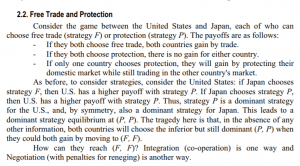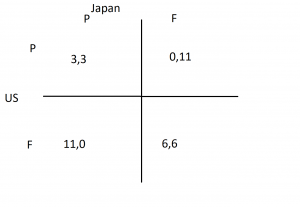Game Theory in International Trade
[ http://feaa.ucv.ro/RTE/010-18.pdf ]
One of the hot topics of the 2016 political season was trade and its role in the American economy. International trade is a very complex subject, but it comes from a view that seeks to maximize certain aspects that are defined by its proponents as desirable. Its proponents say that delivering goods at the lowest cost possible is economically stimulating, and allows for greater specialization, as each nation would only produce the goods that they have a comparative advantage in. They also point to the fact that many countries rely on exports for economic strength, and trade barriers may block those exports from reaching their intended targets. Its detractors, however, point out that removing trade barriers will reduce the amount of jobs in many sectors, as the labor will be outsourced to countries in which compensation laws and regulations regarding benefits and workplace safety may be less.
Game theory may apply here, in this case, in a variety of ways. In the linked document, Prof. Dobre I. Claudia states many examples, and this post will attempt to address the one that I believe to be the most clear explanation of questions regarding trade in the modern US.
Claudia in this example creates a simple game in which the players can either choose Free trade or Protectionism, and accurately lays out that trade leads to growth in the economy. She also, however, points out that it is in each individual country’s best interest to keep trade barriers as high as possible, so that they gain from not only exporting to their counterpart, but also from their own domestic market choosing to buy their goods. However, this creates a form of Prisoners Dilemma, as both countries are have incentive to pick protectionism, which stifles growth from trade, leaving both countries in a much worse state than they would have been had they both picked free trade, but a better position than if their respective countries had picked free trade, and the other picking protectionism. Below is a possible visual form of the described game.


